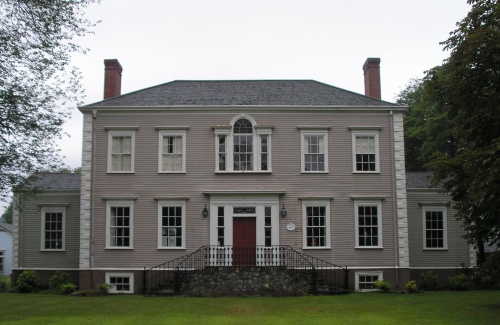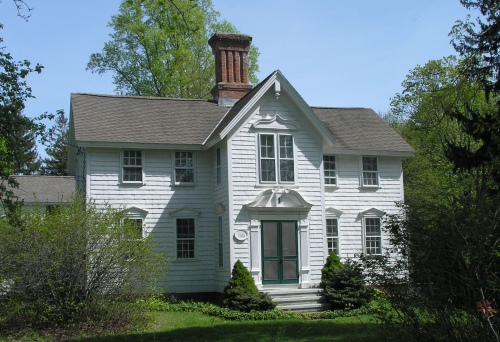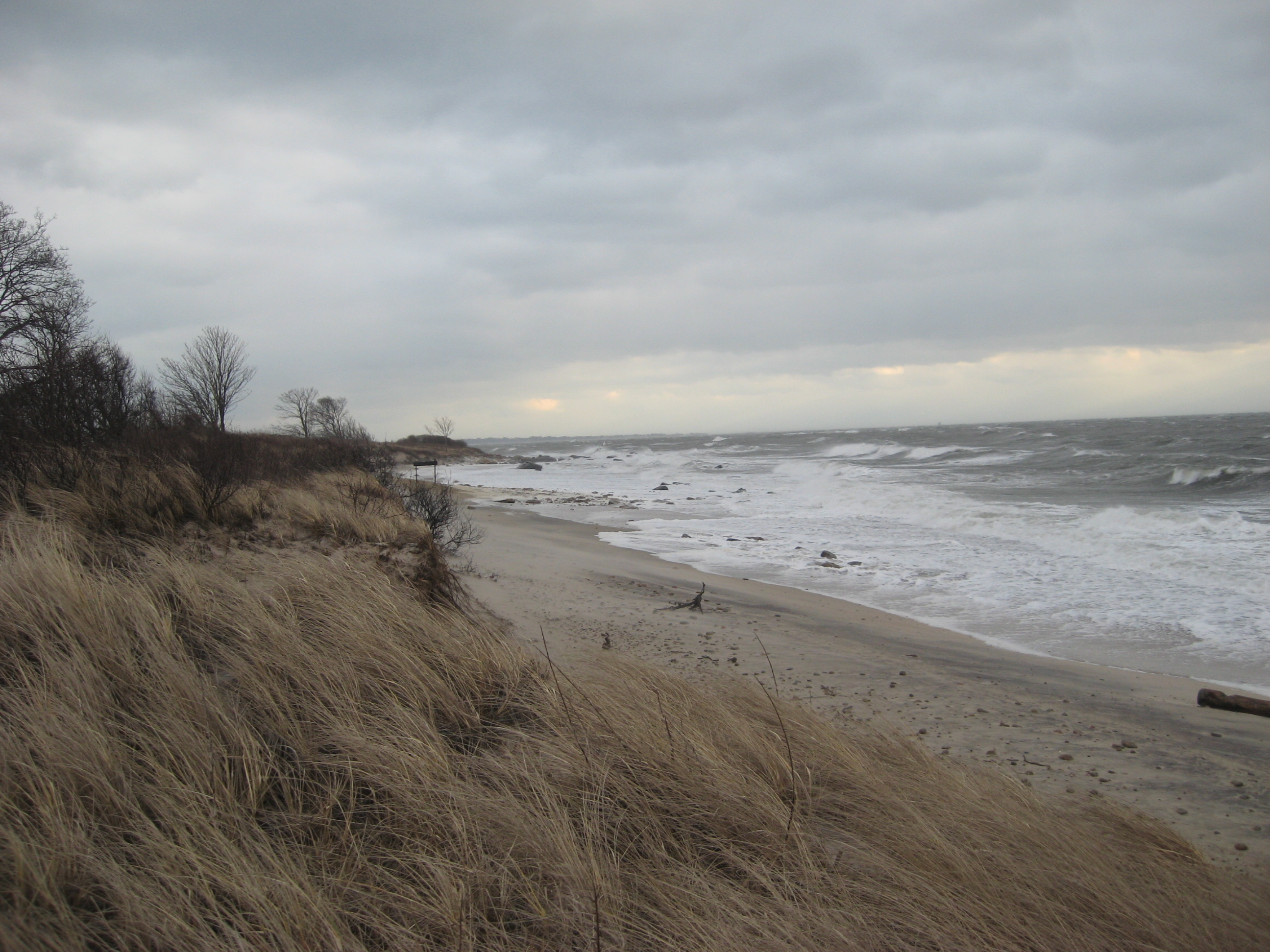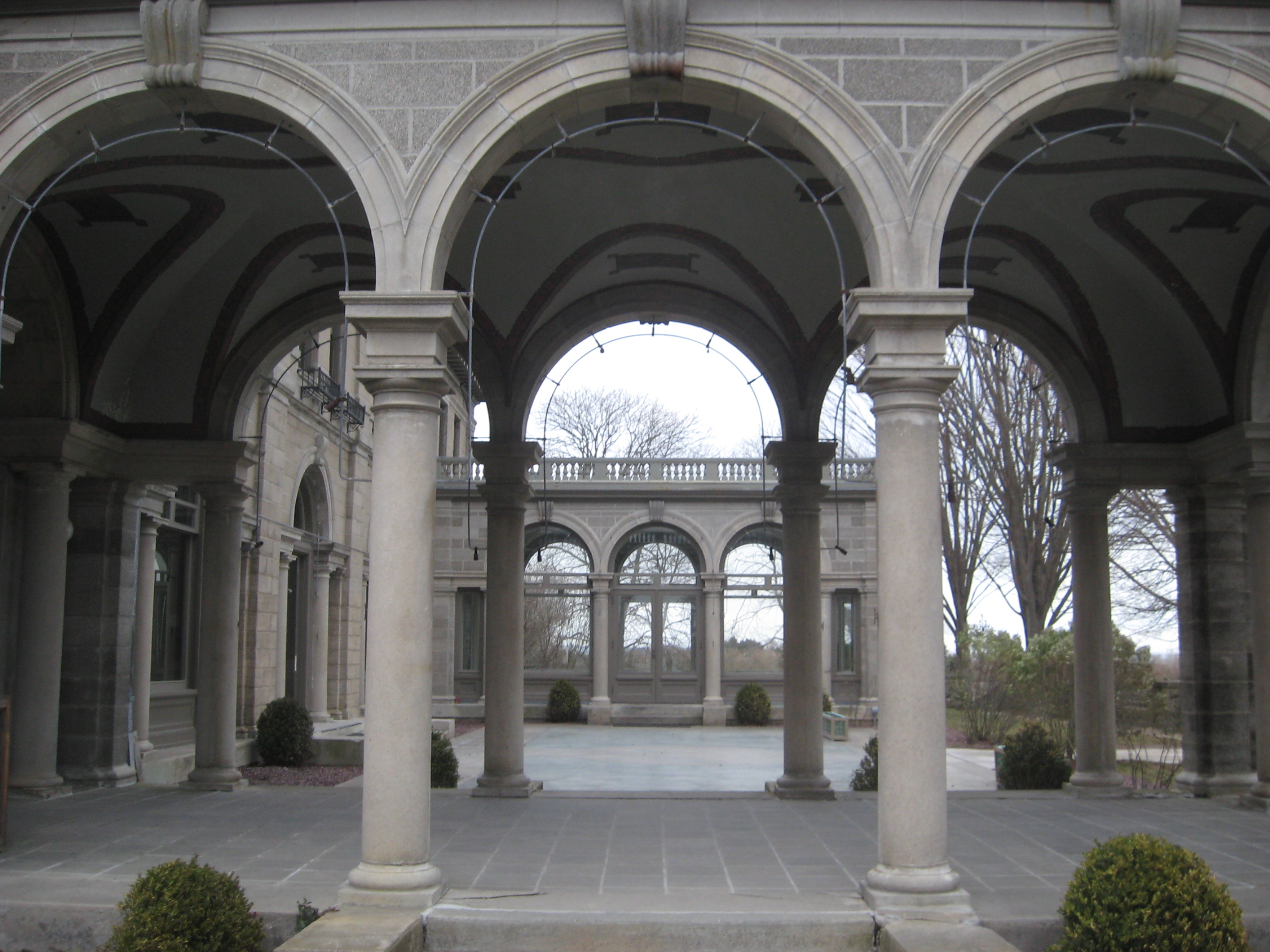We took to the road on a recent chilly morning, one of the very few cold days of this rare and welcome winter, for unplanned discoveries in eastern Connecticut. The radio was off. The sound of the tires on asphalt offered more than enough enjoyment, a bittersweet echo of our cross-country camping trip of 2009. On occasions like these, stretches of silence will be broken only by Nonnie’s one-word identification of the license plate of a passing vehicle. Wisconsin. Idaho. New Mexico. The shared rising feeling mingles nostalgia, pride, and expectation touched with rue. Will we ever hit the road like that again? These shorter day trips quicken the pulse: yes, we will.
We drifted out toward Old Lyme, East Lyme, and South Lyme, pulling off Route 95 for roads that sound promising–Shore Road, Neck Road, Rope Ferry Road, 4 Mile River Road–and any left or right that catches our eye. Grand old trees spread out over the roadways, bare branches waving in the stiffening wind. Architectural delights abound: stern mansard roofs, graceful molded cornices, towers and turrets both rounded and square.

The John Sill House, on Lyme Street in Old Lyme, Connecticut, was built around 1817. Sill was a smuggler who hid his booty in secret closets built throughout the structure. He enjoyed the dwelling for only three years, losing it in the wake of his arrest in 1820. (Historic Buildings of Connecticut image)
From time to time we’d stop and park the car to get a closer look. The temperature was below freezing, and the rising wind, abetted by a winter sun hanging low in the sky, drove us back quickly to the warmth of the car. I had neglected to bring a hat and gloves, a bad move.

With a stark yet reassuring grace, the John McCurdy House sits right across from the daunting First Congregational Church of Old Lyme. It was built around 1700 by the perfectly named Amos Tinker. General Washington, we are told, spent a night here in April 1776, while on his way from Boston to New York. We shall not question it. (Historic Buildings of Connecticut image)
After a nice lunch and a glass of wine at the cozy Black Sheep Tavern, on Main Street in Niantic, we drove east by Jordan Cove and decided to head for the coast. The wind seemed even stronger, shaking the car now and then, and a cover of thick gray clouds now fully obscured the sky. How had we not seen that happen? Attracted by a sign for Harkness Memorial State Park, we caught a glimpse of ocean and turned south off Great Neck Road. Ours was the only car in the parking lot. We could see the roiling Atlantic about 1,500 feet away, beyond a broad expanse of lawn. Let’s do it–we’ve come this far. Nonnie pulled her scarf over her head, I jammed my hands into my jacket pockets, and we made a dash for the water. The wind was so strong and my fingers so cold, I had trouble keeping the camera still.

The falling mercury and the strengthening gale conspired to make the beach grow more distant with each step.

The bitter wind, now gusting past 40 mph, lacerated us with sand from the beach. The sign to the left, Nonnie bravely discovered, reads "No Swimming."

Flecks of snow were starting to appear, making it all but impossible to imagine a string quartet, croquet, and a bottomless Pimm's Cup.

"On the table was spread a snow-white tablecloth; upon it was a splendid porcelain service, and the roast goose was steaming famously with its stuffing of apple and dried plums."

As soon as we returned home, Nonnie planted herself at the iMac to discover the identity of the gardens' architect. It was the work of the extraordinary Beatrix Jones Farrand, one of Nonnie's favorites. A wonderful surprise.

Farrand fell in love with landscape while summering at her family home on Mount Desert Island, in Maine. During trips to England she visited the estimable Gertrude Jekyll and William Robinson. As if that weren't enough, Edith Wharton was her aunt. Farrand designed the kitchen garden at The Mount, Wharton's estate in Lennox, Massachusetts.
The estate was called Eolia, and the forty-two-room mansion became the summer home of Edward S. Harkness, who inherited a fortune thanks to his father’s investments in a promising company called Standard Oil. Harkness bought the property in 1907, when he was thirty-three. He was worth about about $155 million when he died, at the age of sixty-six, in 1940. That’s about $2.4 billion today. Harkness had deep pockets but a bottomless heart. His philanthropy extends far beyond this beautiful estate, set so dramatically against Long Island Sound. He gave away nearly $130 million, making major donations to the Metropolitan Museum of Art, the New York Public Library, and Columbia-Presbyterian Hospital. Countless colleges, universities, and boarding schools benefited from his charity, and the Yale School of Drama and its theatre were created through his gifts. A peerless legacy.
Later, while reading up on Harkness, I came across an article by Richard F. Niebling, in the Fall 1982 issue of The Phillips Exeter Bulletin, commemorating the fiftieth anniversary of the Harkness Plan, a $5.8 million bequest that significantly enlarged the Academy and established endowments. Niebling notes that the recipients of Harkness’s substantial gifts were varied, but that two overarching observations can be made of all of them: “…they all received Harkness’s personal attention, and none of them, in their material embodiment, were allowed, during his lifetime, to bear his name. Where the name Harkness is attached to some building, it commemorates another Harkness–for instance, the Harkness Pavilion in New York City honors his mother; The Harkness Tower at Yale, his brother. There is no Harkness dormitory at Exeter or college at Yale or house at Harvard. He was a very modest man.”






